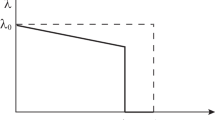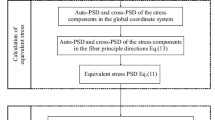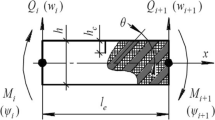Abstract
The algorithm for calculating a fatigue crack formed in force parts of structures under the harmonic vibration load has been presented. The source data for calculating an unknown quantity are fatigue curves in the material and the assumed linearity of the first section of the kinetic diagram of the fatigue fracture. All of the necessary parameters for describing the law of crack propagation in the form proposed by Paris are determined by the characteristics of the fatigue curve. This approach shows that the fracture of the thin-walled force parts of structures with a thickness of less than 2 mm (the size of a fatigue crack for which the fracture of samples is tested to develop the fatigue curve) occurs at a smaller number of cycles than that shown in the fatigue curve for the same stress amplitude.
Similar content being viewed by others
References
Soprotivlenie ustalosti metallov i splavov. Spravochnik (Fatigue Resistance for Metals and Alloys. Handbook), Troshchenko, V.T. and Sosnovskii, L.A., Eds., Kiev: Naukova dumka, 1987.
Ekobori, T., Nauchnye osnovy prochnosti i razrusheniya materialov (Scientific Foundations of Materials Strength and Fracture), Kiev Naukova dumka, 1978.
Broek, D., Elementary Engineering Fracture Mechanics, Leyden: Nordhof Int. Publ., 1978.
Cherepanov, G.P., Mekhanika khrupkogo razrusheniya (Mechanics of Brittle Fracture), Moscow: Nauka, 1974.
Stress Intensity Factors Handbook, Murakami, Y., Eds., Tokyo: Pergamon Press, 1987.
Normy rascheta na prochnost’ oborudovaniya i truboprovodov atomnykh energeticheskikh ustanovok (Strength Calculation Norms for Pipelines and Equipment of Nuclear Power Plants), Moscow: Energoatomoizdat, 1989.
Ivanova V.S., Ustalostnoe razrushenie metallov (Metals Fatigue Fracture), Moscow: Gos. Nauch.-Tekh. Izd., 1963.
Stepanov, M.N. and Giatsintov, E.V., Ustalost’ legkikh konstruktsionnykh splavov (Fatigue of Light Structure Alloys), Moscow: Mashinostroenie, 1973.
Ivanova, V.S. and Terent’ev, V.F., Priroda ustalosti metallov (Nature of Metals Fatigue), Moscow: Metallurgiya, 1975.
Ivanova, V.S. and Shanyavskii, A.A., Kolichestvennaya fraktografiya (Quantitative Fractography), Chelyabinsk: Metallurgiya, 1988.
Oding, I.L., Dopuskaemye napryazheniya v mashinostroenii i tsiklicheskaya prochnost’ metallov (Permissible Tensions in Machinery Manufacturing and Metals Cyclic Strength), Moscow: Mashgiz, 1962.
Author information
Authors and Affiliations
Corresponding author
Additional information
Original Russian Text © S.K. Agafonov, 2016, published in Problemy Mashinostroeniya i Nadezhnosti Mashin, 2016, No. 5, pp. 75–81.
About this article
Cite this article
Agafonov, S.K. Vibration strength of structures based on the theory of cracking and fatigue curves. J. Mach. Manuf. Reliab. 45, 451–457 (2016). https://doi.org/10.3103/S1052618816050022
Received:
Published:
Issue Date:
DOI: https://doi.org/10.3103/S1052618816050022




